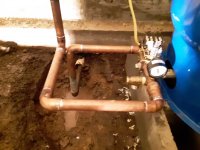Richard D White
New Member
The PO of my home had a well installed long before he built the house. The spin fiberglass pressure tank is buried next to the well head. He always had trouble with the switch freezing so when the house was built he ran a 1/4" line from a nipple on the pitless adapter into the crawlspace and put the guage and switch there. Problem is when it gets below zero the small line will still freeze up. Bottom line is that I waited until now when the ground is frozen to deal with it. I want to move the pressure tank under the house but I don't want to dig everything up right now. Can I just plug that 1/4" line off and put a Tee in the main line that comes in the house and install a new tank and switch? Will this set up effect my outside hydrants which then would be up stream of the new tank? Can I just leave the old tank in the ground hooked up without a switch?

